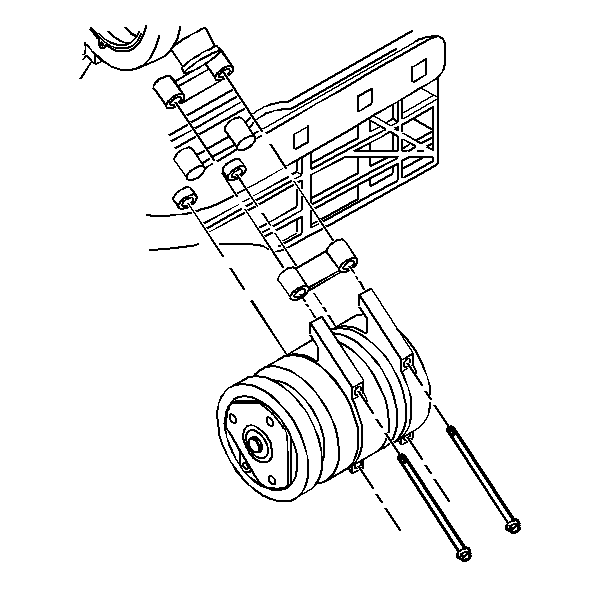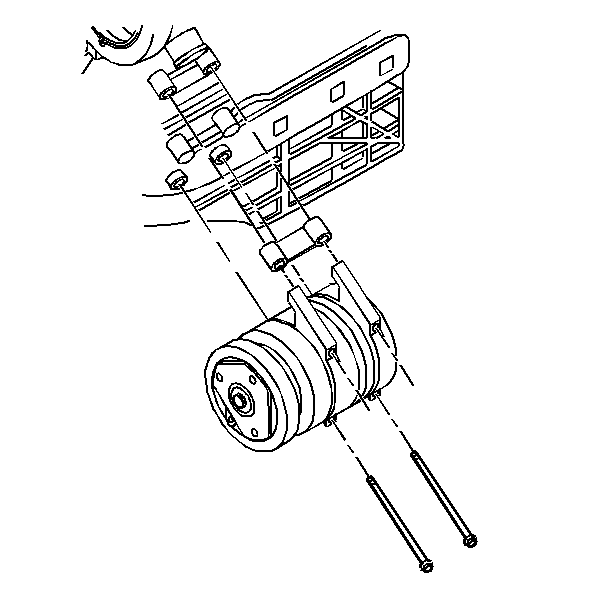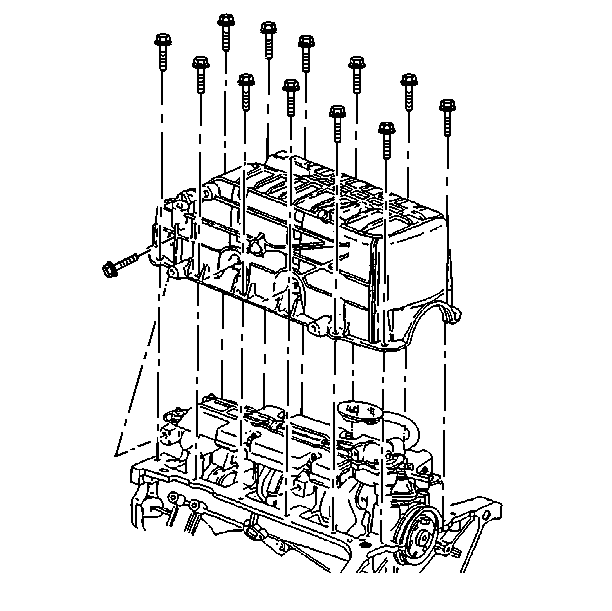Removal Procedure
Caution: Unless directed otherwise, the ignition and start switch must be in the OFF or LOCK position, and all electrical loads must be OFF before servicing
any electrical component. Disconnect the negative battery cable to prevent an electrical spark should a tool or equipment come in contact with an exposed electrical terminal. Failure to follow these precautions may result in personal injury and/or damage to
the vehicle or its components.
- Disconnect
the negative battery cable.
- Remove the drive belt. Refer to
Drive Belt Replacement
.

- Loosen the upper A/C compressor
bolts, if equipped. Do not remove the bolts.
- Raise the vehicle. Support the vehicle. Refer to
Lifting and Jacking the Vehicle
in General Information.
- Drain the crankcase.
- Remove the right front tire and wheel assembly. Refer to
Wheel Removal
in Tires and Wheels.
- Remove the right splash shield. Refer to
Wheelhouse Splash Shield Replacement
in Bumpers.
- Remove the right front ABS wheel speed sensor harness from the
right suspension support.
- Remove the right front ball joint. Refer to
Lower Control Arm Ball Joint Replacement
in Front Suspension.
- Remove the right side stabilizer link. Refer to
Stabilizer Shaft Link Replacement
in Front Suspension.
- Remove the right side suspension support. Refer to
Front Suspension Crossmember Replacement
in Front Suspension.

- Remove the lower A/C compressor
bolts.
- Position the compressor aside. Support the compressor.
- Remove the engine to transmission brace.
- Remove the oil filter.
- Remove the starter. Refer to
Starter Motor Replacement
in Engine Electrical.
- Remove the flywheel inspection cover.

- Remove the oil pan side
bolts.
- Remove the oil pan bolts.
- Remove the oil pan.
- Remove the oil pan gasket.
- Clean the following items:
Installation Procedure

- Install a new gasket.
Place sealant on the oil pan gasket tabs if you are installing the rear main
bearing cap. Place the sealer on the tabs that insert into the gasket groove
of the outer surface on the main bearing cap. Use GM sealant P/N 1052080 or
its equivalent.
- Install the oil pan.
Notice: Use the correct fastener in the correct location. Replacement fasteners
must be the correct part number for that application. Fasteners requiring
replacement or fasteners requiring the use of thread locking compound or sealant
are identified in the service procedure. Do not use paints, lubricants, or
corrosion inhibitors on fasteners or fastener joint surfaces unless specified.
These coatings affect fastener torque and joint clamping force and may damage
the fastener. Use the correct tightening sequence and specifications when
installing fasteners in order to avoid damage to parts and systems.
- Install the oil
pan retaining bolts.
Tighten
Tighten the retaining bolts to 25 N·m (18 lb ft).
- Install the oil pan side bolts.
Tighten
Tighten the side bolts to 50 N·m (37 lb ft).
- Install the transmission converter cover.
- Install the starter. Refer to
Starter Motor Replacement
- Install the oil filter.
- Install the engine to transmission brace.

- Loosely assemble the A/C
compressor spacer and the upper bolts. Secure the spacer and the bolts in
place.
- Install the A/C compressor to the engine. Refer to
Air Conditioning Compressor Replacement
in HVAC Systems with
A/C - Manual.
- Install the right side suspension support. Refer to
Front Suspension Crossmember Replacement
in Front Suspension.
- Install the right side stabilizer bar. Refer to
Stabilizer Shaft Replacement
in Front Suspension.
- Install the right side ball joint. Refer to
Lower Control Arm Ball Joint Replacement
in Front Suspension.
- Connect the right front ABS wheel speed sensor harness.
- Install the right splash shield. Refer to
Wheelhouse Splash Shield Replacement
in Body Rear
End.
- Install the right front tire and wheel assembly. Refer to
Wheel Installation
in Tires and
Wheels.
- Lower the vehicle.
- Install the drive belt. Refer to
Drive Belt Replacement
.
- Fill the crankcase.
- Connect the negative battery cable.





